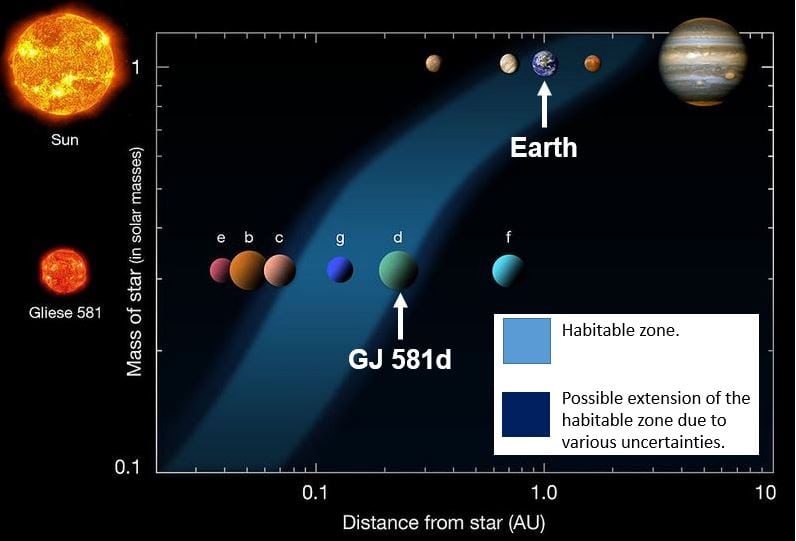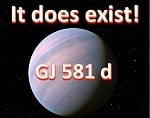There is a planet 20 light years away in the ‘Goldilocks Zone’ that scientists refer to as GJ 581d. In 2014, astrophysicists said it did not exist, claiming their false readings were due to cosmic noise created by starspots (sunspots in stars). British scientists are now saying the method they used for finding smaller exoplanets was no good and that GJ 581d does exist.
The exoplanet (a planet outside our solar system) orbits Gliese 581, a red dwarf in the constellation Libra. Red dwarfs are old, small cool stars.
GJ 581d is in the ‘Goldilocks Zone’, known technically as the ‘Circumstellar Habitable Zone’ or simply the ‘Habitable Zone’ – the region around a star within which a planet could have sufficient atmospheric pressure and liquid water to support life as we know it. In other words, as in the fairy tale ‘Goldilocks’, where conditions are ‘just right’.

If the latest findings are accurate, GJ 581 could be the most Earth-like exoplanet discovered so far.
Scientists from Queen Mary University in London and the University of Hertfordshire have just completed a study and published their findings in the journal Science which challenges the methods used last year to conclude that the mysterious signals pointing to GJ 581d were just cosmic noise and no such planet existed.
Last year, scientists used a spectrometer to decide on the candidate exoplanet. This device measures the miniscule changes in the wavelength of light that a star emits. When orbiting planets move in front of the star it can cause a “wobble” in the readings.
The mysterious signal was initially collected in 2007, and then examined more closely in 2014, when scientists concluded there was no planet there and the data was simply ‘noise’ caused by starspots. They said their evidence was compelling and the matter seemed settled…, that is, until this latest study.
Old method no good for spotting smaller planets
The British researchers claim the statistical technique used last year to account for the star’s activity was inadequate for spotting smaller exoplanets like GJ 581d.
It is a good method for detecting the larger exoplanets, where the wobble effect is big enough to negate other variables. However, it is useless for spotting small planets that are close to the star or within the noise caused by its own variability.

The habitable zone of Gliese 581 compared with our Solar System’s habitable zone. (Image: Wikipedia)
Lead author Dr. Guillem Anglada-Escudé, from the School of Physics and Astronomy at Queen Mary University of London, and Dr. Mikko Tuomi, from the Centre for Astrophysics Research at University of Hertfordshire, say that after checking the data using a more accurate model, they are “highly confident” GJ 581d really is a planet, despite starspot noise, and it is in the Goldilocks Zone.
Dr. Anglada-Escudé, commented:
“The existence, or not, of GJ 581d is significant because it was the first Earth-like planet discovered in the ‘Goldilocks’-zone around another star and it is a benchmark case for the Doppler technique.”
“There are always discussions among scientists about the ways we interpret data but I’m confident that GJ 581d has been in orbit around Gliese 581 all along. In any case, the strength of their statement was way too strong.”
“If they way to treat the data had been right, then some planet search projects at several ground-based observatories would need to be significantly revised as they are all aiming to detect even smaller planets. One needs to be more careful with these kind of claims.”
How Earth-like could GJ 581d be?
If Drs. Anglada-Escudé and Tuomi are right, GJ 581d could be the most Earth-like exoplanet discovered so far, according to the Earth Similarity Index. However, its surface could be completely different.
Studies point to GJ 581d having a much denser atmosphere than Earth’s, while the dim light coming from its dwarf star could make for a very cold and gloomy environment that would be uninhabitable for humans.
The Earth Similarity Index, also known as the Easy Scale, is a measure of how physically similar a planet is to Earth. It is a scale from zero (completely different) to one, with Earth having the value of one.
GJ 581d has been given an Index of 0.89, making it the most Earth-like planet so far.
Reference: Guillem Anglada-Escudé and Mikko Tuomi. “Comment on ‘Stellar activity masquerading as planets in the habitable zone of the M dwarf Gliese 581′,” Science. Published on 6th March, 2015. DOI:10.1126/science.1260796.
Video – The exoplanet GJ 581d

